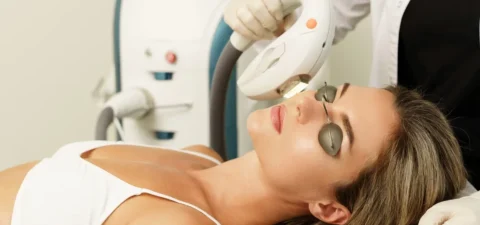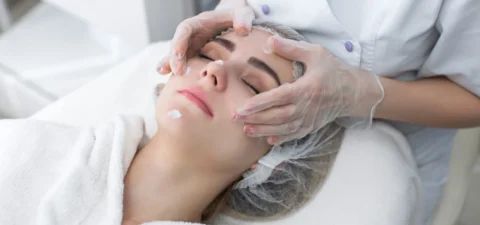For information only. Not meant as advice in any form. Please consult your medical professional or lawyer.
Estheticians are some of the most in-demand providers of skin and body treatments – but the process of becoming one takes some investment in time and effort. Before administering a single skin treatment, an esthetician needs to fulfill hour upon hour of training at an esthetics school, pass the state board examination, and finally get their license to practice esthetic treatments.
How many hours does it take for someone to get through esthetician school and become a master esthetician? The exact number varies between states, but you should expect to take about 600 hours on average to finish an esthetics program. With effort, it’s possible to become an esthetician within a year – though this depends on a lot of factors.
How Many Hours Are Needed For An Esthetician License?
The exact number of hours needed to get an esthetician license are different between states – Utah requires 600, while Nevada requires 900. Keep in mind that these aren’t specifically training hours either: these should be done with an accredited esthetics or cosmetology school, with an esthetician program that’s recognized by your state’s board of cosmetology.
Between learning the science of skincare, skin analysis, practical training, and on-the-job experience, you can expect to spend a little under 1000 hours to qualify for your license. If you add specific tracks like massage therapy, nail technology, hair removal, or makeup application, a student is looking at around 1500 hours to become a well-rounded licensed esthetician.
How Long Are Esthetician Programs?
An esthetician program will typically take around 8 to 10 months to finish, though this will depend on three key factors:
- The course load you’re able to get as a student. Full-time students will finish their training earlier than part-time students, though the overall differences between either student are negligible in the long run.
- Apprenticeship and on-the-job experience. Some students will also work for esthetics practices while attending their training, which can lengthen the process needed to get an esthetics degree.
- Specialty courses or tracks. Some esthetics programs allow you to choose a specialty in which you can learn more about specific types of skin care treatments or procedures. These programs may add more hours to your basic track.
Keep in mind that esthetician programs will vary depending on your institution, so ask your admissions officer or search on the beauty school website about the specifics of your chosen esthetics program.
Why Do The Hours Differ Between States?
Your state board of cosmetology (or its equivalent) usually has specific guidelines in place about how many hours someone needs before they become a licensed esthetician, but why do requirements differ between states?
There are several reasons for this:
1. Accounting For Consumer Demand
Some places (usually the more metropolitan areas) see high demand for cosmetic services. To account for this demand, states have come up with stringent rules to ensure that those who enter the esthetician market provide a high quality of service.
However, demand for esthetician services (or skin care services) will vary from state to state, and if a state doesn’t have high demand, it will tend to have more lax requirements – or a smaller number of overall hours. But this isn’t the rule either: some states like Florida may see high demand for estheticians, but can also have lower hours required for getting a license.
Overall, it’s really a balance between how big the skincare market is in your state and how strict is your state board of cosmetology regarding the hours needed for esthetician programs.
2. Keeping Services Competitive
Because the demand for skin care and esthetician services can change between states, the different hours between one state and the other is a way of ensuring competitiveness between estheticians. Estheticians can request reciprocity or endorsement of their licenses to other states – and this can be a problem if the level of training they’ve received is different in their home state.
Most states generally have allowances for substituting hours and training (and may often require passing an exam), but keeping hours different between states ensures a competitive market. This way, estheticians from other states don’t gain an advantage in a market without the same amount of training other estheticians already in the state have gone through.
Keeping services competitive ensures that patients receive the best type of care possible, but it also makes sure that services overall are kept at a great level across the state.
3. Having Different Legislations
Sometimes the reason why the hours are different in one state all goes down to legislation. Since state governments (and by extension, the cosmetology boards of each state) have plenty of leeway in setting the standards for estheticians, legislation or lobbying will place a role in how accessible getting those licenses will be.
States that have significant investments in beauty culture and the skin care industry, they’re more likely to draft legislation that favors efficient processing for aspiring estheticians. This doesn’t mean that their requirements are any easier, but it does mean that they’ll be different from states that don’t have the same investment.
The vast majority of states tend to have the same average (around 600 hours) required for estheticians, mostly because it’s not uncommon for legislation to be adopted across state lines. Still, you should always check with your state about how many hours you need to qualify for a license – and with any state that you want to transfer your license.
Adding More Hours
Given that you’ll need anywhere from 250 to 1900 hours to finish esthetician school, is there any point in adding even more hours on top of the ones that you need to qualify? While most students may be tempted to simply go straight to the state board exam, there are actually some significant benefits if you decide to study a little more.
1. Easier Reciprocity/Endorsement
Finishing an esthetician program in your state doesn’t mean that you’re only allowed to practice esthetic treatments in your home state. Licensed estheticians can practice skin care treatments in other states through reciprocity or endorsement, drastically widening their potential client base.
Typically, the hours that you’ve spent in esthetician school factor heavily for reciprocity and endorsement requirements, followed by on-the-job experience or training. Because states differ on how many training hours are required for an esthetician’s license, having more hours in training is generally a good way to avoid complications with this requirement entirely.
States can also accept apprenticeship hours in place of academic training, but this is not guaranteed across states and may require extra academic hours to become valid. Overall, getting more hours in esthetician school is a safer option.
2. Higher Earning Opportunities
More hours in esthetician school means a higher quality of practical training -as well as a lot of flexibility with the different treatments that you can administer. This is especially true if you’ve pursued a specialty esthetician program since you often have in-depth knowledge and practical training that graduates from a basic esthetician program can’t match.
One of the biggest factors that are limiting the earning opportunities of licensed estheticians in the United States is the variety of treatments they can administer. If you have more training hours, you’re more knowledgeable about skin care treatments – and therefore can charge more.
This is especially useful if you happen to work in a state that has a high demand for estheticians since you can directly correlate the number of hours that you have at esthetician school to the price of your services. While practical training and on-the-job experience do still play a factor in your earning opportunities, more hours on paper tend to translate to higher payments.
3. Pursuing Continuing Education
Estheticians can administer a wide variety of skin care treatments, but they’re not allowed to administer advanced skin care procedures like Botox or dermal filler. In many cases, only medically-trained staff are allowed to these treatments, which estheticians technically do not fall under.
Becoming a medical esthetician or cosmetologist can open more doors for you opportunity-wise, but to do that you need to undergo even more training and studies. Having more hours in esthetician school can help you prepare to continue your cosmetic education, and may even help you decide what you want to specialize in after.
Continuing education is always a must for any skincare provider, but it’s especially useful for estheticians who want to improve their craft or get into more career opportunities. With more hours behind you, you’ll have an easier time getting into higher education for cosmetic treatments.
Is There Any Way To Shorten The Hours Required?
Typically, the hours required for esthetician study and training cannot be appealed or changed – however, they can be replaced by apprenticeship or on-the-job training. This is less of “shortening” your hours but rather changing them into other experiences, which can work depending on your plans for getting your esthetician license.
Keep in mind that you still need to check with the requirements of your state if you’re planning on doing this. Some states do not recognize on-the-job training or apprenticeship at all for qualifying for a license, and it can become an issue if you want to request reciprocity or endorsement of your license to other states.
FACE Med Store: Your Partner For Medical-Grade Tools And Supplies
Esthetician school requires a certain amount of training hours depending on your state. But while your esthetics program may end after a few hours, every hour of training that you get is extremely valuable to your overall experience as an esthetician. The more training you get (especially for continuing education or an apprenticeship), the more your skincare treatments will improve.
FACE Med Store has extensive experience in helping providers and patients alike with high-quality yet affordable medical tools and supplies. Whether it’s makeup application or dermal filler treatment, we help licensed estheticians, their practices, and their patients get reliable access to cosmetic and medical treatments alike.
For more information about our products and our services, visit our website today.






